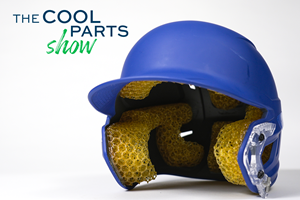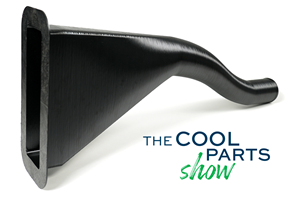Magneto X Desktop 3D Printer Features Linear Motor System
Peopoly’s Magneto X is said to offer improved accuracy and reliability at higher print speeds, as well as a more streamlined motion system compared to printers that rely on belts and stepper motors.
Share
Read Next
The Magneto X offers a more streamlined motion system compared to those reliant on belts and stepper motors. Photo Credit: Peopoly
Peopoly’s Magneto X fused filament fabrication (FFF) 3D printer is designed to offer new standards for speed, precision and reliability. The printer has been designed from the ground up to enhance and optimize the performance of desktop 3D printing. Based on familiar FFF technology, the Magneto X goes beyond traditional belts and pulleys, enabling high-speed, great surface finish and precise 3D printing at the desktop — all powered by magnets.
The Magneto X features Peopoly’s MagXY magnetic levitation linear motor system for the X and Y axes, achieving unprecedented repeatability of 3 microns. This motion system does away with belts and pulleys, thereby eliminating common artifacts such as ringing and vertical fine artifacts (VFA). In contrast to traditional stepper motors (which can suffer from reduced precision under heavy loads), the MagXY system remains cool, sustaining its accuracy through a true closed-loop system with position feedback.
The MagXY also offers a more streamlined motion system compared to those reliant on belts and stepper motors. Traditional belts not only require periodic tension adjustments but also experience wear and tear, which can complicate maintenance. In contrast, the clean, simplified design of the MagXY linear motor system expedites tasks like extruder replacement, as there are no belts to disconnect or obstruct access. Its lower rail friction also enhances useful life span and reduces the need for frequent calibration, ultimately lowering downtime and saving costs for professionals in the long run.
The printer offers optimized performance for speed and extrusion. Magneto X achieves print speeds of up to 1,200 mm/sec. and a maximum acceleration of 22,000 mm2/sec., made possible by its low-friction linear motor. However, speed is just one aspect of reliable, high-quality printing. The other key factor is the extrusion system’s ability to extrude plastic quickly and consistently. Magneto X’s Lancer extruder delivers an extrusion force of 90 N and a filament speed of 30 mm/sec. Its variable-length melt zone enables a maximum flow rate of up to 60 mm3/s, facilitating rapid printing without sacrificing quality. The printer uses a standard E3D V6 volcano-style nozzle, ensuring easy replacement and broad filament compatibility.
The Lancer extruder also has a load cell sensor and a filament runout sensor. Initially, the load cell sensor calibrates the four independently driven Z-axis rods to level the build plate. Following this, the extruder performs a 48-point mesh measurement on the heated build plate, capturing detailed data for calibration. Magneto X then uses this mesh data to set the Z-offset, ensuring precise auto leveling. The filament sensor continuously monitors material levels to prevent print failures due to material depletion.
Magneto X offers a 400 x 300 x 300-mm build volume and features four independently driven Z-axes for enhanced stability and leveling accuracy. It is equipped with a 300°C hot end and includes 0.4 mm copper and hardened steel nozzles. These specifications make it compatible with a variety of materials such as PLA, PETG, ABS, ASA and Nylon-Carbon Fiber.
Running on Klipper firmware and featuring a 7” IPS touchscreen, the printer offers an intuitive user interface. It supports Orca Slicer, PrusaSlicer and Cura, and provides multiple connection options such as WiFi, Ethernet and SD card offline mode. Peopoly supports the open-source community and sponsors OctoPrint and Orca Slicer. Magneto X operates on Klipper firmware with a transparent code base. It neither requires a network connection to function nor sends or stores data in the cloud, ensuring operability alongside full security and IP protection.
Related Content
3D Printed Lattices Replace Foam for Customized Helmet Padding: The Cool Parts Show #62
“Digital materials” resulting from engineered flexible polymer structures made through additive manufacturing are tunable to the application and can be tailored to the head of the wearer.
Read MoreFDA-Approved Spine Implant Made with PEEK: The Cool Parts Show #63
Curiteva now manufactures these cervical spine implants using an unusual 3D printing method: fused strand deposition. Learn how the process works and why it’s a good pairing with PEEK in this episode of The Cool Parts Show.
Read MoreAircraft Ducts 3D Printed in Composite Instead of Metal: The Cool Parts Show #68
Eaton’s new reinforced PEKK, tailored to aircraft applications, provides a cheaper and faster way to make ducts compared to formed aluminum.
Read MoreUnderstanding PEKK and PEEK for 3D Printing: The Cool Parts Show Bonus
Both materials offer properties desirable for medical implants, among other applications. In this bonus episode, hear more from Oxford Performance Materials and Curiteva about how these companies are applying PEKK and PEEK, respectively.
Read MoreRead Next
Alquist 3D Looks Toward a Carbon-Sequestering Future with 3D Printed Infrastructure
The Colorado startup aims to reduce the carbon footprint of new buildings, homes and city infrastructure with robotic 3D printing and a specialized geopolymer material.
Read MoreCrushable Lattices: The Lightweight Structures That Will Protect an Interplanetary Payload
NASA uses laser powder bed fusion plus chemical etching to create the lattice forms engineered to keep Mars rocks safe during a crash landing on Earth.
Read MoreBike Manufacturer Uses Additive Manufacturing to Create Lighter, More Complex, Customized Parts
Titanium bike frame manufacturer Hanglun Technology mixes precision casting with 3D printing to create bikes that offer increased speed and reduced turbulence during long-distance rides, offering a smoother, faster and more efficient cycling experience.
Read More





















